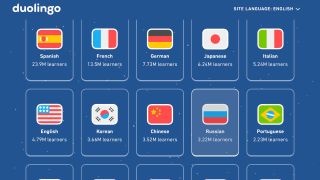Recent updates
This article was updated November 2023
Duolingo gamifies language learning in a way that is so powerful many apps have copied it since its launch. It is now the name synonymous with digital language learning.
As such, this can be a powerful tool to employ as a supplement to a traditional language lesson. Use it in class as a reward that keeps them learning, or supplement homework with this as a way to continue development.
Many language options are currently available, with more added regularly, from Spanish and French to Korean and Japanese – and it's all free. You can sign up for premium features, but it's not required to get access to the learning resources.
Expect this to work on varying skills areas, including reading, writing, speaking, and listening.
This guides aims to show you all you need to know about Duolingo, including how it can best be used for teaching.
What is Duolingo?
Duolingo is a game-style language learning tool that's based online. It offers a digital way to learn a whole host of new languages for students of varying ages and abilities. Thanks to smart algorithms, this can even adapt to help specific students in areas they need, but more on that later.

Duolingo comes in app form as well as being available on the Dualingo site itself. This makes it super accessible, and it can be downloaded by students onto their own devices. This kind of access, along with the ability to create game avatar characters, adds up to a great sense of ownership for students. All that helps make this more immersive and a tool that students choose to come back to.
That all said, there are teacher-level controls that allow for specific learning goals which can focus on words, grammar, or skills. More features are available in the Duolingo for schools version but more on that below. Needless to say, when paying for it the ads are removed, but there are also offline courses and more.
What's new in Duolingo?
The Duolingo home screen has had a major redesign to help make learning more effective, says the company. Now students should be shown the perfect lesson at exactly the right time to help make step-by-step progress more efficient.
This works by mixing older lessons with new materials so as to create a more intuitive outcome, specifically to help learning stick with students to cement lessons.
How does Duolingo work?
Duolingo is free to access and can be signed up to get started working with immediately by students. Download the app, go to the website, or use the Chrome app to get going. Or assign student accounts if you're a teacher using the schools version of the platform.

Duolingo starts by giving you a choice of languages to pick from with more than 36 options. For pure beginners, there are basic lessons to get started with right away. For those who already have a level of understanding, a placement test can be taken to determine the right starting point.
Students create their own cartoon avatar character and then navigate the learning games to earn rewards. A streak count for the most days in a row spent learning with the tool is available. XP points can be earned for time when using the app. Badges can be displayed on the avatar profile, while flag icons show the languages they're learning. Finally, there are gems that can be earned that are spent to change avatars and buy cosmetic upgrades. An overall mastery level shows the number of words they've learned.
What are the best Duolingo features?
Duolingo uses a really helpful self-correcting learning system that shows students when they've made an error and also lets them see the correct answer right away. This makes the platform a suitable way to learn independently.

Duolingo requires students to go back and forth between their native language and target language across reading, writing, speaking, and listening. In the stories section, students can practice more conversational, situation-based skills.
In the paid version there is smart adaption in which learning is targeted based on the mistakes a student has made and on areas in need of improvement.
In the free version for schools teachers can add class sections, link student accounts, and track progress. Teachers can set stories to work on conversational skills or they can set specific grammar or vocabulary areas for improvement.
Teachers are able to see generated reports that show at a glance the XP earned, time spent, and progress toward goals of each student as well as an overall course view.
How much does Duolingo cost?
Duolingo comes in a free version that features near complete functionality but is ad supported. The free schools version for teachers and students has extra features focused on teaching, goals, and feedback.
Duolingo Plus is $6.99 per month after a 14-day free trial. This removes advertisements and adds features such as unlimited hearts, a progress tracker, streak repair, practice mistakes, mastery quizzes, and unlimited test outs.
Duolingo best tips and tricks
Get guided
Duolingo has created a free guide that helps teachers get started using the service in class, offering guidance and advice. Check it out here.
Make points real
Apply points rewards in the class, giving students extra privileges as their XP level ranks up in the Duolingo world.
Run camps
Setup extra class groups for afterschool and break-time activities so students can keep progressing and maintain momentum in their learning.

